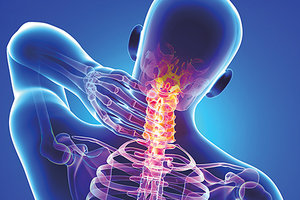While much more chiropractic research needs to be done – and many more doctors of chiropractic need to participate in research endeavors – it's gratifying to know existing research has made a lasting impression.
Rankings were determined by performing citation analysis – "the current de facto gold standard for measuring the impact of scientific literature," according to Nicola Rüegsegger, et al. – on cervical spine research papers published in any medical or nonmedical journal between 1900 and 2014. The top 100 studies appeared in 30 different journals between 1952 and 2008. Spine and the Journal of Bone and Joint Surgery yielded the most publications in the top 100 (42 research papers combined).
The papers had a low of 173 citations (#100) and a high of 879 citations (#1); with 877 total citations, the Vernon / Mior paper finished a close second and topped the list with 88 citations in 2014.
By comparison, the #1 and #3 studies were cited only 77 times combined in 2014; to which the authors of the citation analysis commented: "It is therefore possible, that in upcoming years, [the Vernon / Mior paper] might become the new number one in cervical spine research in terms of citations." Rüegsegger, et al. provided further insight regarding the top three papers, particularly the Vernon / Mior accomplishment:
 "Out of the top three publications, two [#1 and #3] were published in 1958 and both described the anterior removal [surgical] of cervical intervertebral discs – the 1st ranking one was published by Cloward and the 3rd placed by Smith and Robinson. Despite their age, both studies are still 'highly active' with 31 and 46 citations in 2014, respectively (average citations in 2014 for all studies listed: 14). ... Second placed is the publication by Vernon and Mior from 1991 describing the Neck Disability Index, which modifies the Oswestry Low Back Pain Index for its use for the cervical spine. ... The Neck Disability Index paper happened to be the most-cited study in 2014.
"Out of the top three publications, two [#1 and #3] were published in 1958 and both described the anterior removal [surgical] of cervical intervertebral discs – the 1st ranking one was published by Cloward and the 3rd placed by Smith and Robinson. Despite their age, both studies are still 'highly active' with 31 and 46 citations in 2014, respectively (average citations in 2014 for all studies listed: 14). ... Second placed is the publication by Vernon and Mior from 1991 describing the Neck Disability Index, which modifies the Oswestry Low Back Pain Index for its use for the cervical spine. ... The Neck Disability Index paper happened to be the most-cited study in 2014.
"Interestingly, in a recently published bibliographic study of the lumbar spine, a review of the Oswestry Low Back Pain Index published in 2000 is the third most cited lumbar spine paper. This highlights the importance pain and disability classifications play in clinical practice, both for the lumbar and the cervical spine."
The Vernon / Mior study investigated reliability and validity of the 10-item scaled Neck Disability Index. In the study, 17 consecutive whiplash patients presenting to an outpatient clinic were evaluated using the NDI, demonstrating test-retest reliability. Concurrent validity was assessed via two methods: 1) percentage change in NDI score before and following treatment compared to VAS scores of perceived improvement of activity levels (subset of 10 patients who completed a course of conservative care); and 2) comparison of NDI scores with McGill Pain Questionnaire scores (larger subset of 30 patients).
According to the authors, "While the sample sizes of some of the analyses is somewhat small, this study demonstrated that the NDI achieved a high degree of reliability and internal consistency. As well, it appears to be sensitive to the levels of severity of complaint, and to changes in severity in the course of treatment."
Claire Johnson, DC, MSEd, editor in chief of JMPT and National University of Health Sciences' two other journals (Journal of Chiropractic Medicine and Journal of Chiropractic Humanities) commented on the Vernon / Mior paper and the significance of its high ranking on the top 100 list:
"Authority and influence of a profession can be measured by the level of contribution that it has made to advance the science of the field. After a research study has been published, others will cite the work as a means of building upon previous knowledge. Therefore, measuring citation rate is one way to assess the influence of a scientific paper.
"What is commonly known throughout the world as the 'Neck Disability Index,' or NDI for short, was first published in [JMPT] in 1991. The NDI is a validated outcome measure that helps identify a patient's level of pain and function. The NDI is well-suited not only for daily clinical practice to measure the response to care, but also has contributed to research, since its scoring method can be used for statistical analysis.
"According to the most recent study published in Spine, not only is the paper by Vernon and Mior on the list of most influential papers, but it is listed as number 2 out of 100, which is quite an accomplishment. At the time the NDI paper was published, only a handful of chiropractic-related research papers were available. Thus, not only is the Vernon / Mior paper an important contribution to chiropractic research; it is now recognized as one of the most influential papers of all time for cervical spine research."
Resources
- Vernon H, Mior S. The neck disability index - a study of reliability and validity. JMPT, 1991;14:409-15.
- Rüegsegger N, et al. The 100 most influential publications in cervical spine research. Spine, 2015 Nov 2. [Epub ahead of print]
Dynamic Chiropractic editorial staff members research, investigate and write articles for the publication on an ongoing basis. To contact the Editorial Department or submit an article of your own for consideration, email
.




